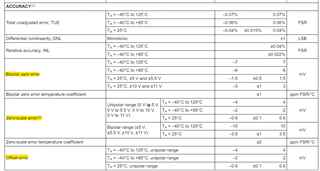Tool/software:
Dear Technical Support Team,
1. If I’d like to set output 0V (exactly 0V) using the voltage output on the DAC7760, is it necessary to use dual power supplies such as ±15V or ±5V? The voltage output range is 0V-5V.
2. What data sheet specifications should I refer to in order to compare the error relative to 0V for bipolar 0V and unipolar 0V?
Bipolar zero error, zero-scale error, or offset error?

3. Since the headroom is -0.5V, does AVDD need to be 5.5V or more to output 5V? Also, if the footroom is -0.5V, is there a possibility that the output will be -0.5V if ADSS=0V?

Best Regards,
ttd

